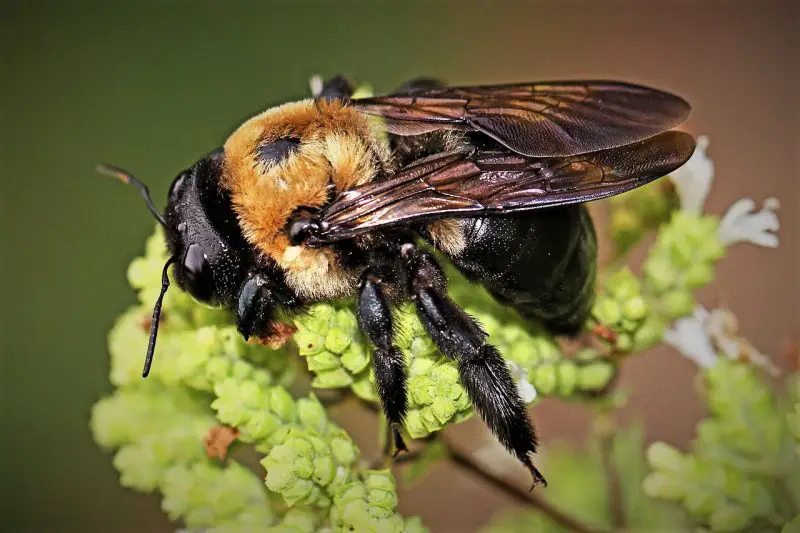Carpenter bees are often mistaken for simple wood pests in Tennessee, yet their sturdy build, metallic sheen, and tunneling behavior reveal a species with far more ecological importance than most people realize. Although they are frequently mistaken for bumblebees, carpenter bees possess a distinct biology, set of behaviors, and seasonal patterns that make them unique members of the state’s pollinator community.
In Tennessee, where humid summers meet mild winters and forests blend with urban development, carpenter bees have carved out a niche that allows them to thrive. These insects exhibit surprising nesting strategies, complex territorial displays, and highly efficient pollination functions that deeply influence local ecosystems. While their wood-boring behavior may cause structural issues, their natural history is far more intricate than many people realize.
This article explores ten scientific, surprising, and rarely discussed facts about carpenter bees in Tennessee, revealing how these insects behave, why they matter, and the ecological stories hidden within their buzzing flights.
1. Carpenter Bees in Tennessee Are Not as Destructive as Many People Believe

Wood-boring Behavior Has Strict Biological Purpose
Carpenter bees drill into wood not to eat it but to create nesting tunnels. Their mandibles are powerful yet precise, allowing them to excavate smooth passageways where they store pollen and lay eggs. These tunnels function as nurseries, protecting larvae from predators and extreme weather.
The purpose of drilling is reproductive, not destructive. Only female bees possess the drilling ability, and they choose wood that is untreated, weathered, or softened by exposure. This selection is rooted in energy efficiency, as softer wood reduces excavation time.
Most structural damage occurs when bees return to the same site for multiple generations. A single season of tunneling rarely results in serious harm unless the wood is already weakened or never maintained.
Tennessee’s Climate Makes Certain Wood Types More Vulnerable
Humid, wet conditions in Tennessee accelerate wood aging, making decks, siding, and porches more susceptible to carpenter bee attention. Bees prefer surfaces with minimal paint or sealant, as untreated or sun-exposed wood provides ideal texture for drilling.
Areas with strong afternoon sunlight are especially attractive. Carpenter bees select warm wooden surfaces because heated wood layers are easier to bore through, reducing energy expenditure.
This preference explains why homeowners often notice activity around eaves, rails, and fence posts.
Natural Predators Slow Tunnel Expansion in the Wild
In forests, carpenter bee tunnels do not become extensive because natural predators such as woodpeckers uncover and consume larvae. This predation limits tunnel growth and restricts colony expansion.
The absence of these predators near homes allows some tunnels to become multi-year structures. Understanding this natural balance helps explain why carpenter bee damage is mostly concentrated in human-built environments rather than forests.
2. Male Carpenter Bees Are Aggressive but Cannot Sting
Territorial Flights Are Defensive Displays
Male carpenter bees are highly territorial. They hover in front of people, animals, or other insects, creating the illusion of aggression. This behavior intensifies during breeding season when males defend areas near nesting tunnels.
Their flight pattern is a communication strategy, not a prelude to attack. By hovering directly in front of intruders, they signal that the space is occupied and that rivals should stay away.
Despite their bold demeanor, males remain harmless because they lack stingers.
Females Can Sting but Rarely Do
Female carpenter bees possess stingers but are notably docile. They sting only when physically handled or severely threatened. Their primary focus is tending to nests, gathering pollen, and excavating tunnels.
This low aggression makes carpenter bees safer to observe compared with wasps or hornets. Homeowners often mistake their large bodies and loud buzzing for danger, but the actual risk of stings is minimal.
Even during nest-building season, females prefer retreating into tunnels rather than confronting threats.
Territorial Behavior Helps Protect Nest Entrances
Male bees hover near entrances to prevent predators or rival males from approaching females. This instinct is part of a broader reproductive strategy aimed at increasing mating opportunities.
These aerial patrols appear intimidating but serve a biologically important role in maintaining genetic success.
3. Carpenter Bees Are Among Tennessee’s Most Effective Pollinators
Their Large Bodies Allow Efficient Pollen Transfer
Carpenter bees have broad thoraxes and strong leg structures that collect pollen easily. Their large bodies brush against floral reproductive parts, boosting pollination efficiency.
Unlike honeybees that target specific flowers, carpenter bees explore a wider range, supporting the pollination of diverse plant species.
This versatility benefits Tennessee’s wildflowers, fruit trees, and garden plants.
Buzz Pollination Enhances Fertilization of Many Crops
Carpenter bees perform “buzz pollination,” a technique where they vibrate their flight muscles to shake pollen loose from flowers that require mechanical stimulation. Plants such as tomatoes, blueberries, eggplants, and peppers rely heavily on this process.
Tennessee growers benefit from this natural service, especially in rural areas where agricultural plots border natural bee habitats.
Buzz pollination improves fruit quality and seed production, underscoring the species’ ecological value.
They Supplement Pollination Gaps Caused by Honeybee Declines
As honeybee populations face disease, parasites, and environmental stressors, native pollinators like carpenter bees play an increasingly important role in Tennessee’s ecosystems.
Their resilience, solitary nesting habits, and adaptable foraging behavior help stabilize pollination networks across the state.
These contributions often go unnoticed despite their ecological significance.
4. Carpenter Bees Use Highly Structured Tunnels Called “Galleries”
Tunnels Follow a Consistent Architectural Pattern
Each tunnel begins with a round entrance hole roughly the diameter of a finger, leading into a straight shaft that runs parallel to the wood grain. From this shaft, females create side chambers where they deposit pollen and eggs.
This organized structure maximizes tunnel stability and allows multiple larvae to develop simultaneously.
The smooth interior walls are sculpted with precision, showcasing the refinement of their excavating abilities.
Wood Type Influences Tunnel Layout
In Tennessee, carpenters bees often target softwoods such as cedar, pine, and cypress. These species allow quicker excavation and provide durable chambers.
Hardwoods like oak or maple are rarely targeted except when heavily weathered. The wood’s density affects tunnel length, chamber spacing, and the energy needed for construction.
Tunnel systems can extend several inches if the wood remains soft and accessible.
Older Galleries Are Often Reused by Multiple Generations
Carpenter bees prefer reusing old galleries rather than excavating new ones, especially when existing structures remain intact. This reuse can give the impression of expanding infestations, when in reality bees are recycling established tunnels.
Generational reuse also helps preserve energy during breeding season, allowing females to focus on provisioning rather than excavation.
This behavior is common throughout Tennessee’s residential and forested areas.
5. Carpenter Bees Are Affected Strongly by Tennessee’s Seasonal Cycles
Spring Marks the Peak of Mating and Excavation
As temperatures warm in March and April, carpenter bees emerge from overwintering sites and begin seeking mates. Males become highly territorial around nest sites, while females select wooden surfaces for excavation.
Spring is the period of highest activity, with bees inspecting potential wood and beginning pollen collection.
Homeowners often notice this seasonal spike near porches, barns, and wooden sheds.
Summer Is a Period of Larval Development
During summer, most adult bees die off after reproduction. The next generation develops inside the galleries, feeding on pollen loaves prepared by the female.
Larvae mature over several weeks, transforming into pupae and eventually emerging as adults.
This seasonal transformation occurs silently within wooden chambers.
Fall and Winter Are Periods of Low Activity
In late summer or early fall, new adults emerge and feed briefly before seeking shelter. They overwinter inside old tunnels or sheltered wooden cavities.
During winter, carpenter bees enter a period of low metabolic activity to conserve energy. Tennessee’s relatively mild winters make survival easier compared with northern states.
Come spring, overwintered adults restart the cycle.
6. Carpenter Bees Communicate Through Vibrations and Sound
Vibrational Signals Guide Mating and Nesting Behaviors
Carpenter bees use vibrations generated by their wings and thoracic muscles to communicate. These vibrations help males signal territory boundaries and allow females to coordinate within nest tunnels.
Such signals are particularly useful in dark, enclosed galleries where visual cues are limited.
This communication form parallels similar behaviors found in related bee species.
Buzzing Patterns Convey Information
The pitch, duration, and intensity of their buzzing can indicate aggression, curiosity, or alarm. Observers may notice changes in buzzing when they approach nest sites.
Different buzzing frequencies allow bees to coordinate movements, warn intruders, or express distress.
These sound patterns are subtle but significant within their ecological interactions.
Vibrations Aid in Excavation
Vibratory feedback helps carpenter bees assess wood density. By pressing their mandibles and bodies against wood, they detect structural weaknesses and choose the most efficient drilling spots.
This sensory adaptation contributes to the speed and precision of tunnel construction.
7. Carpenter Bees Exhibit Strong Territorial Memory
Males Memorize Specific Airspace Routes
Male carpenter bees patrol defined flight zones, memorizing hover points and angles that allow them to intercept intruders efficiently. Their memory enables consistent, predictable territorial patterns.
They monitor key locations over multiple weeks, demonstrating spatial awareness similar to other solitary bees.
This territorial mapping is especially noticeable during sunny mornings in Tennessee.
Females Remember Optimal Nesting Wood
Female bees revisit wood types and textures that proved successful in previous seasons. Their selection process is based on past experience, habitat conditions, and local food availability.
This memory-based behavior influences where generations of carpenter bees establish galleries.
Such selective nesting contributes to localized patterns of activity.
Memory Supports Efficient Foraging Routes
Carpenter bees remember flower clusters and landscape features that offer reliable pollen. This memory allows them to optimize foraging routes and conserve energy.
Their foraging maps often span dozens of yards and adjust dynamically as floral availability changes.
This trait enhances pollination efficiency across Tennessee ecosystems.
8. Weather Patterns Strongly Influence Carpenter Bee Behavior in Tennessee
Temperature Determines Activity Cycles
Carpenter bees rely heavily on sunlight and warmth. Cool mornings delay flight, while warm afternoons increase foraging and excavation.
Sudden temperature dips suppress activity, forcing bees to remain inside galleries.
This responsiveness ensures energy conservation during unstable spring weather.
Humidity Affects Wood Selection
High humidity softens wood fibers, making drilling easier. Tennessee’s climate encourages bees to target outdoor wooden structures exposed to rain and fluctuating moisture.
Dry wood is less attractive, explaining why sealed or painted surfaces often remain untouched.
Humidity-driven behavior connects carpenter bees closely to local climate patterns.
Storms Influence Foraging Patterns
Heavy rains, thunderstorms, and strong winds disrupt flight paths. Bees reduce outdoor activity during storms, focusing on shelter and tunnel maintenance.
After storms, foraging often increases as bees compensate for lost feeding opportunities.
This behavioral flexibility allows survival in unpredictable weather.
9. Carpenter Bees Coexist With Tennessee’s Other Pollinators
They Rarely Compete With Honeybees
Carpenter bees target different flower structures than honeybees, reducing interspecies competition. Their size allows them to access deeper floral chambers.
Honeybees focus on clustered blooms, while carpenter bees forage over broader areas.
This division of labor supports pollination stability.
They Share Resources With Bumblebees
Carpenter bees and bumblebees often visit similar flowers, but their foraging times differ. Carpenter bees prefer warm mid-day temperatures, while bumblebees tolerate cooler mornings.
This temporal separation reduces conflict and allows both species to thrive.
Both play vital roles in Tennessee’s plant reproduction.
They Serve as Backbone Pollinators in Forested Regions
In rural and forested areas, carpenter bees act as primary pollinators where honeybee presence is low. Their solitary nature allows them to operate independently without colony collapse risks.
This makes them indispensable contributors to Appalachian and Central Tennessee ecosystems.
10. Preventing Damage Without Harming Carpenter Bees Is Possible
Wood Treatment Is Highly Effective
Regularly painting, staining, or sealing wood reduces drilling activity by creating a barrier that repels bees. Treated wood is harder and less appealing for excavation.
Cedar, if left untreated, is especially vulnerable due to its softness.
Homeowners can reduce damage simply by maintaining wooden surfaces.
Providing Bee-Friendly Alternatives Helps Redirect Activity
Installing untreated wooden blocks or bee shelters away from buildings offers alternative nesting sites. These structures give female bees safe, attractive locations to excavate.
Redirecting their natural behavior is more sustainable than removal or extermination.
This method protects both property and pollinator populations.
Timed Repairs and Exclusion Are Key
Sealing tunnels after bees have emerged in late summer prevents reuse. Adding metal flashing to vulnerable areas also discourages nesting.
These strategies allow coexistence without harming the insects that play vital ecological roles.
FAQs About Carpenter Bees in Tennessee
Do carpenter bees cause serious structural damage?
Not usually. Damage becomes significant only after repeated use of the same tunnels over many years.
How do I tell carpenter bees from bumblebees?
Carpenter bees have shiny, hairless black abdomens, while bumblebees have fuzzy, yellow-banded abdomens.
Are carpenter bees aggressive?
Males may hover aggressively but cannot sting. Females can sting but rarely do.
Do carpenter bees pollinate plants?
Yes. They are powerful pollinators and essential to Tennessee’s ecosystems.
When are carpenter bees most active in Tennessee?
Activity peaks in spring during mating and excavation.
Can carpenter bees be relocated?
It is difficult and unnecessary; providing alternative wood often redirects them.
Do they reuse the same tunnels?
Yes, and this reuse causes most structural issues.
Are carpenter bees beneficial?
Absolutely. Their pollination services outweigh potential damage.
Conclusion
Carpenter bees in Tennessee are far more complex than their reputation suggests. From their precision tunneling and advanced memory to their ecological importance as pollinators, these insects demonstrate a remarkable blend of behavior, biology, and adaptation. Although their wood-boring habits create challenges for homeowners, understanding their natural role reveals a species deeply connected to Tennessee’s landscapes.
By learning how carpenter bees interact with climate, vegetation, and human environments, we gain insight into both their survival strategies and the broader ecosystems they support. Coexisting with these insects not only protects vital pollination networks but also preserves the delicate balance of natural processes that define Tennessee’s rich biodiversity.






